Over the last couple of years while using Linux, I've slowly become better at what could loosely be described as "hacking".
Now DON'T PANIC! - don't get me wrong - I'm not some Linux guru who can cut perl code with my toes blindfolded...just somebody who sometimes at a very low level likes taking someone else's code & modifying it for my own needs. Sometimes I might even improve on the original! *cough*.
I mainly focus on stuff that is Palm related, mainly trying to integrate some of the command line tools available for Linux->Palm connectivity with some well known Linux applications.
Iverson-Gleeson Bent Middle Finger Grip (& other thoughts...)
I know what you are saying!!!! What on earth is a Iverson-Gleeson bent middle finger grip? And what on earth does it have to do with a website about PalmPilots, Tandy's & Linux???? Well for the unitiated, I'm talking about cricket! Nothing todo with technology. Its my website and I'II do what I want!
I think its my responsibilty to revive a forgotten art in spin bowling. An art that could revolutionise modern spin bowling! Forget about "Chucker" Murali or "Stoner" Warne. THIS IS WHAT THE YOUNG KIDS SHOULD BE PRACTISING!
This story starts in the early 1950's and kinda ends in the early 1970's in Australia. This story is also focused on 2 cricketers - John Brian Iverson and John William Gleeson. Christopher Martin-Jenkins (Martin-Jenkins, pg41 & 61, The Complete Who's Who of Test Cricketers, 1987) has a great career summary of these 2 cricketers below:
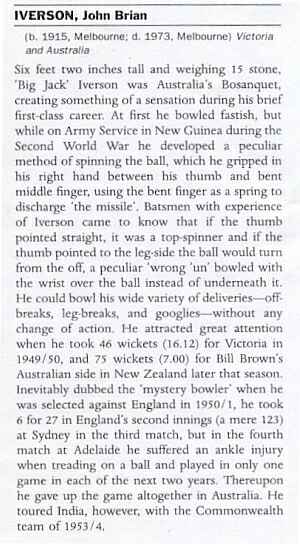
|
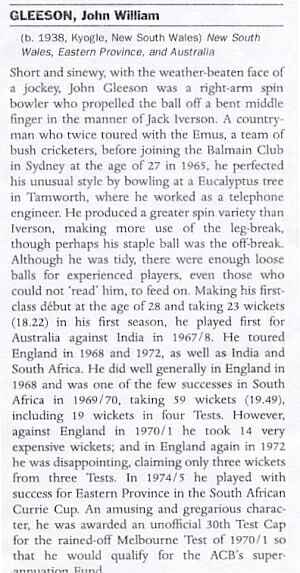
|
As can by seen, both of these bowlers where considered "mystery" bowlers with this perculiar "bent middle finger" grip.
So what did this grip look like? Well below I have 2 pictures showing exactly the grips they both employed.
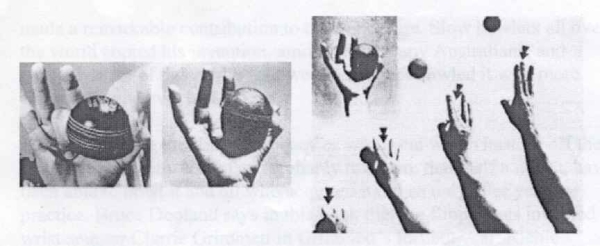
Jack Pollard (Pollard, file attached, Cricket - The Australian Way, 1972) describes the above
"...Left Johnny Gleeson's grip, right Jack Iverson's grip, demonstration
of Iverson flicking the ball out from the middle finger..."
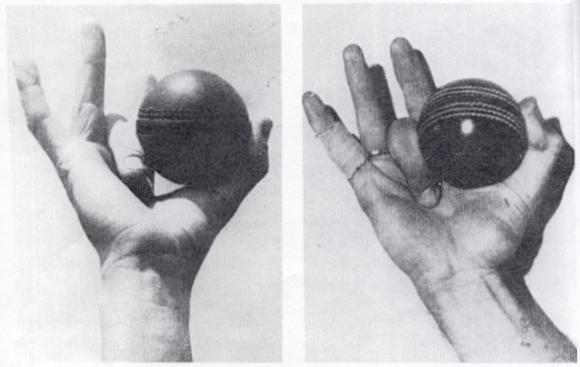
Jack Pollard again (Pollard, pg 76-80, The World's Greatest Leg-Spin Bowlers, 1994) describes the above
"...The grips used by Jack Iverson, left, and Johnny Gleeson, right,
were very similar, and both demanded long fingers. Both flicked the ball
with the finger that was bent behind the ball..."
The best technical explanation of how the grip above works to deliver off-breaks, leg-breaks & top spinners was given by the famous Australian spin bowling coach Peter Philpott (Philpott, pg 74-77, How To Play Cricket, 1973). He described the "...interesting innovation..." thus:
"...Years ago the googly was an unorthodox and mysterious delivery.
It has of course become a straight forward delivery because players
understand how it is bowled and meet up with it frequently. The same
acceptance will come for the Iverson-Gleeson type of delivery, which
still confounds many batsmen. When we examine and understand these
deliveries, they too are straight forward and simple to detect.
Jack Iverson apparently conceived this spin type when flicking a table
tennis ball in his fingers. His gigantic hands easily adapted this to
a cricket ball.
Let's examine the method. The ball is held between the thumb and bent
middle finger (see illustration), and spin is imparted by the flicking
and straightening of that finger. The remainder of the fingers do not
participate, which means that the middle finger is solely responsible
for spin. Clearly your fingers must be strong, and preferably your hand
large
To allow the middle finger to flick the ball in an anti-clockwise
direction (leg-spin), the bent middle finger must be outside the ball.
Thus for a leg-break the hand cuts OUTSIDE THE BALL -the normal off-break
position.
For the off-spin, the hand must turn inside the ball to allow the middle
finger to flick the ball with a clock-wide spin. Such a hand position is
that of an orthodox leg spinner, yet for Iverson and Gleeson it creates
off-spin..."
Later Philpott goes onto explain how he saw the future of the "...Iverson method...".
"...Eventually I see the Iverson method being best employed by an
orthodox off-spinner. Instead of a basic Iverson attack with occasional
orthodox off-spin, there is a great future for an accurate off-spinner who
produces a difficult to detect leg spinner every now and then. I could
visualise such a bowler causing great concern amongst batsmen, and young
off-spinners might be well rewarded for experimentation in this field..."
Another great technical analysis related to bowling has to be New Zealands own Brian Wilkins with his book "The Bowler's Art". Brian describes the method here (Wilkins, pg 157, Cricket: The Bowler's Art, 1997):
"...While the little finger can probably be dismissed, even from a
supportive role, not so the thumb. The thumb is one of a notable spinning
pair in what has been named the "lverson grip", after Jack lverson
(1915-1973). It has also been called the "lverson-Gleeson grip" (since
that used by Johnny Gleeson is virtually identical), but could properly be
renamed the "Armstrong grip". Warwick Armstrong (1879-1947), Australian
captain and all- rounder, used the three-point grip of thumb, first finger
and second firiger , fifty years before Jack lverson...Where Armstrong,
lverson, and Gleeson differ, however, is in the variations they used to
accompany the leg-break. Armstrong didn't bring the ball back from the off
but lverson did, by letting the ball go when the back of this hand was
facing the batsman. By this means he converted anti-clockwise spin to
clockwise. Gleeson also bowled this ball, but added a normal off-break to
his repertoire, thus having two types of off-break to add to his
leg-break..."
As can be hopefully seen. The potential to develop such grips & integrate it with orthodox off-break bowling could potentially reap huge rewards for a bowler! Gleeson himself described what delivery's he actively used (Pollard, file attached, Cricket - The Australian Way, 1972)
"...At the moment I can bowl the top-spinners, wrong-un and leg breaks
with the finger bent back behind the ball, and an orthodox leg cutter and
off - break. I am working on acquiring an orthodox leg-spinner and wrong-un,
which would give me the full range of possibilities -and on bowling what I
have got more accurately. Unquestionably, the ball turns more and sharply
with the Iverson grip, than with orthodox spinning grips..."
Gleeson went onto describe his own thoughts on the advantage the bent finger grip allows a bowler...
"...The enormous advantage the bent finger Iverson type grip gives a bowler
is that if the batsman starts to detect it, he can revert to orthodox spin.
His entire range of deliveries is doubled, and this gives him more chance of
staying one step ahead of the batsman..."
As for what speed the delivery's should be bowled at, from his own experience...
"...For me, the Iverson-type balls have to be delivered at a slow medium
pace, which is probably faster theoretically than spinners should operate.
I tried to bowl them slower and rely more on flight, but I found that the
batsman could play back and wait for whatever turn was on the ball. Bowling
at this pace you minimise the time the batsman have in which to change their
minds.
With the bent finger grip, the ball does not cut down sharply onto the pitch
as the orthodox leg-break do, and so the advantages of flighting the ball
well up are partly lost. Maybe someday a bowler will learn variations of
flight with the Iverson grip. But I can get an occasional ball to hang, as
I bowl with the breeze, looking for a caught and bowled if the batsman fail
to get to the pitch of the ball..."
Here is a piccie of John Gleeson bowling
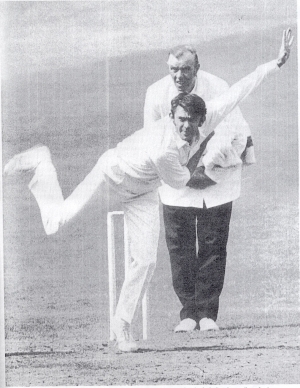
Here is a youTube movie showing how I believe the Iverson-Gleeson method works.
In the movie, the hand position is how the batsman would view it when
delivered.
Another good article on the mystery of Gleeson appears on Cricinfo.
Will leave it to none other than the great Richie Benaud to describe what he felt the contribution of Iverson and Gleeson meant to him (Benaud, pg 140, My Spin on Cricket, 2005)...
"...There have been plenty of spin bowlers around for more than a
hundred years but the four, for me, who have broken the mould and
made batsmen think seriously about what was coming down the pitch at
them, have been Bernard Bosanquet, Jack Iverson, John Gleeson and Shane
Warne..."
and (Benaud, pg 144-148)...
(about Iverson)
"...Iverson was something else. When I batted against him in 1950 at
the MCG, the advice I was given was that he must be treated as
an offspinner, even though for all the world his hand action looked as
though he was bowling leg-breaks..."
"...I made 68 when it came to my time to bat and was missed stumping
once, by Ian McDonald off Iverson, when I dragged over the popping
crease, playing at a ball which my eyes told me was a leg-break and my
mind should have told me, as well as McDonald, was his normal
offspinner..."
(about Gleeson)
"...This day at Gunnedah I went around behind the bowler's arm with
a pair of binoculars after a time because the batsmen seemed to be
having an extraordinary amount of trouble in 'reading' Gleeson. We
had heard he was unusual, but surely not this unusual? It seemed easy
enough from the car. When it came to my turn to bat, he ran up and
bowled me what was obviously an off-break pitching on middle-and-leg
and I turned it behind square-leg. Or rather I would have done that,
other than the fact the 'keeper had taken it outside off stump and
thrown it back to Gleeson...
...With Gleeson it was definitely a case of loving the game and
enjoying bowling so much that he was constantly experimenting with
different deliveries, always trying to find something new. That's
the way bowling should be. He could bowl leg-breaks, topspinners and
wrong'uns with his thumb and middle finger behind the ball, and he
could bowl orthodox offspinners as well..."
Another good reference on this technique was mentioned by the former great England wicketkeeper Alan Knott (Knott, pg 107-108, Stumper's View, 1972).
"...Gleeson holds the ball between the thumb and second finger, which is
bent. The forefinger juts out straight and the top part does not touch the
ball...The second finger, the spinning agent, is laid along the seam and, as
he delivers, this finger flips out powerfully from its bent position as he
undercuts the ball, making his leg-break look like an off-break. There is
virtually no wrist movement and on delivery the palm of his hand is towards
the batsman. He bowls two types of delivery which come into the right-hander.
For his off-break the protruding finger is brought down onto the seam
just before delivery and the wrist turned slightly clockwise.
His second delivery is bowled more like a googly with the back of the
hand facing the batsman but, again, with minimal wrist movement on delivery.
He was still flicking the ball out this time over the top of his hand, with
his powerful second finger but since his wrist was facing a different way, so
the ball turned in the opposite direction.
On English wickets, which are more responsive, to orthodox spin, he
prefers the former delivery, but in Australia where wickets are conducive to
bounce, he generally uses the latter..."
The famous former Australian leggie & laterly cricket journo for the Sun-Herald in Sydney, Bill O'Reilly, wrote this interesting piece on Gleeson during Gleeson's dominating performances against the West Indies in Australia in 1968/69.
Bill O'Reilly, The Sun Herald, Jan 12 1969
"Sun-Herald" cricket expert BILL O'REILLY, in this special report, names
unorthodox Australian spin bowler John Gleeson as the dominating influence in
the Test series with the West Indies.
GLEESON IS KEY FIGURE - LACKS SUPPORT
Two Australians have taken control of this Test series against the West Indies.
With the bat, Ian Chappell has struck gold so richly that he must be considered
the best batsman in the world today.
But the one who has played the biggest part in the humbling the West Indies is
our unorthodox spinner John Gleeson.
No West Indian batsman has looked like detecting his bowling secrets.
Take for instance Garfield Sobers, who has faced up successfully to all the best
bowlers in the game.
His reputation is such that no bowler would dare to believe him a subject of
trickery.
In Wales last season he cracked six sixes in one six-ball over.
But Sobers has not even got to first base in solving the problems Gleeson puts
up to him.
The first time they met in Sydney in the State game before the first Test,
Sobers retreated into his batting shell as soon as Gleeson opened fire.
And though he walloped the hide off the rest of the attack, Sobers never failed
to show the greatest respect for the spinner.
This was the performance which insisted upon Gleeson's inclusion in the Brisbane
Test.
His previous showing against Western Australia had done nothing to help his
claims.
Gleeson has gone from strength to strength since Brisbane.
What has he got that has made him such a force in this series?
Most people are intrigued with the fact that he does not turn the ball much.
One never sees the ball change direction excitingly, as it does sometimes when
a slow legbreaker is operating.
Quite so. But he has something much better than that. He can disguise the
direction the ball will take off the pitch.
If a batsman is uncertain where the ball is going it is not neccesary to turn it
a lot. Just the slightest bit makes the turn look important if the batsman has
played down the wrong line.
Thus the centre of the bat becomes the edge.
Gleeson is dominating this series to an extent that even the pace bowlers are
benefiting from the paralysis conjured up by his line.
I wonder, as I see him pushing his straight-wristed deliveries through with
baffling reactions from the batsmen, what results he could get if he were
partnered by a really good leg-spinner who could supply the wrong-un accurately,
or, failing that, a tall left-handed spinner coming in from around the leg side.
Fast bowlers give him no real support. They hope to do just the things he is
doing if they happen to move the ball off the pitch.
His brand of bowling calls for spin support in a big way.
Gleeson is a finger spinner. He can hoodwink a batsman, even one like Sobers by
his chosen use of the first or second finger.
Length is the essential element in his success.
Until the West Indies batsmen discover what makes the Australian spinner tick,
they can devalue their chances of winning the series.
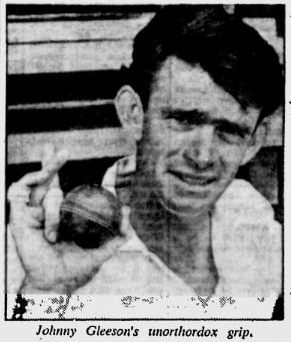 |
I hope someday someone picks up on this type of delivery, as it seems to have been strangely forgotten!? Maybe something todo with the over reliance on Coaching Academys & the like where the orthodox is coached straight from the MCC Coaching manuals, but forgetting about innovation in techniques.
Other Deliveries to consider...
Along with the Iverson-Gleeson method, here are some other grips/techniques that I have thought about that would complement the Iverson-Gleeson method well.
Off-Spin using middle finger & third finger
The traditional off spin grip looks something like this...
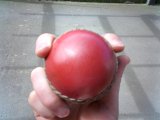
With the traditional off-spin delivery, spin is mainly imparted with the first finger dragging down and across the seam (creating off-spin). However when you research into other techniques, you find that other bowlers like Bob Appleyard, Bruce Yardley, Tom Burtt and Colin Miller decided to change that concept and use what normally is the longer and strongest finger on the human hand to impart spin, the middle finger! (a la the Iverson-Gleeson method). Interestingly all of these players started their careers as medium pacers. A sign perhaps that they weren't "coached" as such to bowl spin, so experimented more in the nets etc & found a method that suited them best. It would make sense if you where to follow the Iverson-Gleeson method that you would also employ a middle finger-third finger grip for orthodox off-spin. The characteristics of the off-spin bowled by Appleyard, Yardley & Miller are that the off-spinners bowled where quicker through the air, spun, and bounced more. This fits in very well with the Iverson-Gleeson method above, as Gleeson himself states that the method is best bowled at a quicker slow medium pace.
Bob Appleyard describes in his book "No Coward Soul" how he came up with the middle finger spinning grip, as well as its characteristics...
"...It was in the Winter Shed during one of those evenings in early 1951 that
the accident happened that transformed Bob's cricketing career.
Yorkshire's bowling attack was in transition. With Alec Coxon gone and Brian
Close still on National Service, only Johnny Wardle of the bowlers in the
Winter Shed was a capped player. Even with the young Freddie Trueman being
pencilled in for an extended run in the first team, there were still vacancies
for an off-spinner and a second new-ball bowler.
Bob knew that his medium-fast bowling would not be sufficient for him to hold
his own at county level, and his first experiments with off-spin had intrigued
the captain Norman Yardley. "He got me to bowl it more often, and he encouraged
the coaches in the Winter Shed to help me to develop it."
After a few such sessions his spinning finger developed a blister, but neither
Yardley nor Bob himself can have anticipated what would happen on the evening
that the blister prevented him from bowling as usual. The batsman in the net was
the 16-year-old Doug Padgett, and Bob still recalls his first delivery to him.
"So as not to stop bowling, I thought I'd bowl it off the middle finger. I ran
up, and I found that I could bowl it much quicker than the normal off-break. I
didn't even have to change my action. The wickets were on springs, I hit them,
and they were all over the place. Arthur Mitchell came over. 'What's going on
here?' he said. I said, 'Just watch this, Arthur,' and I did it again. He looked
at me. 'If you can bowl like that, you can bowl any bugger out.'"
Now he was a two-in-one bowler. He could swing the new ball, he could bowl off-
breaks at some speed, and he did not have to change his run-up. Little did he
realise it as he drove Arthur and Emmott home that night, but his blister had
created the solution to both Yorkshire's bowling vacancies..."
Here are a couple of piccies showing Appleyards grip (bottom), comparing it to the conventional off-break grip (top) - (Chalke & Hodgson, pg 68, No Coward Soul, 2003)
Here are 2 piccies showing what I think the middle finger-third finger off-spin grip looks like.
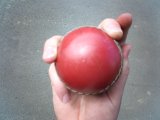 |
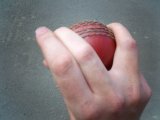 |
| Middle finger-third finger off-spin grip |
View from behind the hand |
From my own testing, once you get used to the new grip, by dragging the middle finger down and across the seam, indeed the ball comes out of the hand quicker, with seemingly more spin imparted on the ball! An interesting thing is when you overlap your first finger over the top of your middle finger, it increases the tension on that side of the ball, enhancing the leverage & spin! Amazing!
Here is a piccie of Bruce Yardley with his off spin grip with the split betwen middle & third finger. Yardley got big spin & high bounce at almost medium pace!
Another notable cricketer to use the middle finger grip is New Zealands very own Tom Burtt! Here is a piccie of his grip from different angles. Very similar to the others.
The Flipper
The famous flipper invented by
Clarrie Grimmett (a New Zealander!) and perfected by
Richie Benaud and
Shane Warne isn't normally bowled by an orthodox finger spinner, mainly because the method involved means a completely different grip & technique which would be easy to pick for a batsmen facing. The flipper is basically bowled by flicking your thumb & middle finger together at release with a slight leg break action/grip. By keeping the wrist over the ball (i.e not allowing the wrist to roll over the ball a la a normal wrist spin leg-break) you actually impart back-spin on the ball. This has the effect of making the ball skid onto the batsmen off the pitch.
However, if you bowl the Iverson-Gleeson top spinner, you will see from the 2 piccies below that the wrist/finger positions at the point of release are very similar for the Iverson-Gleeson top spinner & flipper, only difference being the grip.
 |
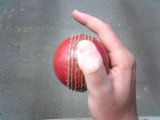 |
| Traditional flipper |
Iverson-Gleeson top spinner |
With some clever hiding of the hand in the bowling action, I think the 2 deliveries would be reasonably hard to pick!
Back-spinning top-spinner
Another delivery I have recently discovered is based on Shane Warne's backspinning top-spinner. Peter Philpott describes this ball best (Philpott, pg 155, A Spinners Yarn, 1990)...
"...Now think! If we continue the adjustment of the wrist just a degree or two
further, continuing to spin with the same leg-break action, the ball has some
back-spin amidst the side-spin.
This creates the leg-spinner's dream ball. For it achieves the back-spin
effect while still using the orthodox leg-spin action..."
He goes onto describe the effect of the delivery...
"It is not only the value of a low skidding straight ball, it is the all-round
effect it has on the bowler's repertoire. For now he is able to vary his bounce
and trajectory and so help to confuse the batsman's judgement of length."
I have recreated this delivery with the Iverson-Gleeson grip. Using the same philosophy, if you release the Iverson-Gleeson grip at more-or-less the same position you'd release an orthodox off-spinner, you create a back-spinning top-spinner!!
Here are 2 piccies explaining what I mean. These are at the point of delivery as the batsmen see's the bowlers wrist.
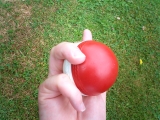 |
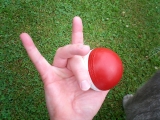 |
| Traditional off-spin (using my technique with middle finger) |
Iverson-Gleeson back-spinner technique |
By flicking the ball out with the middle finger, you are getting the same back-spin/side-spin effect the Philpott talks about. This delivery tends to skid onto the batsmen & bounces lower! Also because position of the wrist is the same as an off-spinner, it would be very hard to pick!
Baseballs "Knuckle Ball"
Watching
ESPN recently I was watching the Boston Red Sox pitcher
Tim Wakefield pitching these intriguing pitches. They are called "Knuckle Balls". When delivered they float out of the hand with no-spin OR revolution on the ball. This allows the prevailing wind to pick it up & do what it likes with the ball. Its normally pitched at about 70mph (much slower than a normal pitch), which fits in nicely with a slow medium Iverson-Gleeson attack if it was bowled instead of pitched!
After some research I found out that former Australian seam bowler Alan Connolly used to bowl knuckle balls as part of his repitoire. He used to be a baseball pitcher in the cricket off-season for Victoria in inter-state matches.
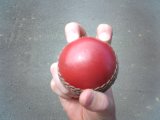
|
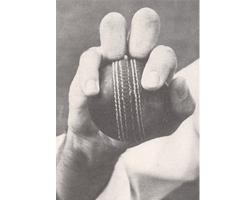
|
| My idea of the knuckle ball |
Another idea of the knuckle ball |
With the Knuckle Ball, with your first and second finger fingernails you attempt to dig into the ball (maybe a semi-legal way of picking the seam?). At the point of release you basically try & "push" the ball out of the hand by just straightening the first & second fingers. With practise you will notice that when the ball is delivered the seam of the ball stays still & parallel to the pitch meaning at the point of release you are not allowing the ball to rotate or spin at all. Who knows what the prevailing wind will do to the ball, and with the batsmen expecting at least some sort of spin on the ball, may be surprised to find the ball not quick arriving, or dipping, and not spinning at all!
The New Yorker has a great article explaining the history of the knuckleball & its characteristcs here.
Feel free to give me some feedback on this topic ...
Bibliography
Brian Wilkins, Cricket: The Bowler's Art, 1997
Christopher Martin-Jenkins, The Complete Who's Who of Test Cricketers, 1987
Jack Pollard, file attached, Cricket - The Australian Way, 1972
Jack Pollard, The World's Greatest Leg-Spin Bowlers, 1994
Peter Philpott, How To Play Cricket, 1973
Stephen Chalke and Derek Hodgson, No Coward Soul, The Remarkable Story of Bob Appleyard, 2003
Richie Benaud, My Spin on Cricket, 2005
Alan Knott, Stumper's View, 1972
Peter Philpott, A Spinner's Yarn, 1990
| Back |
Thats all folks at the moment! If I come up with anything else I'II post it here.


